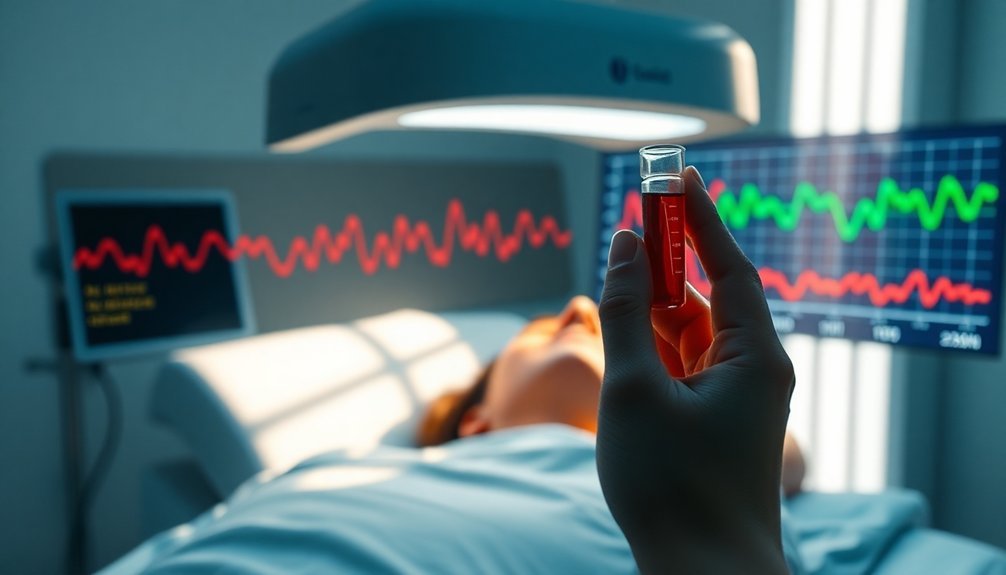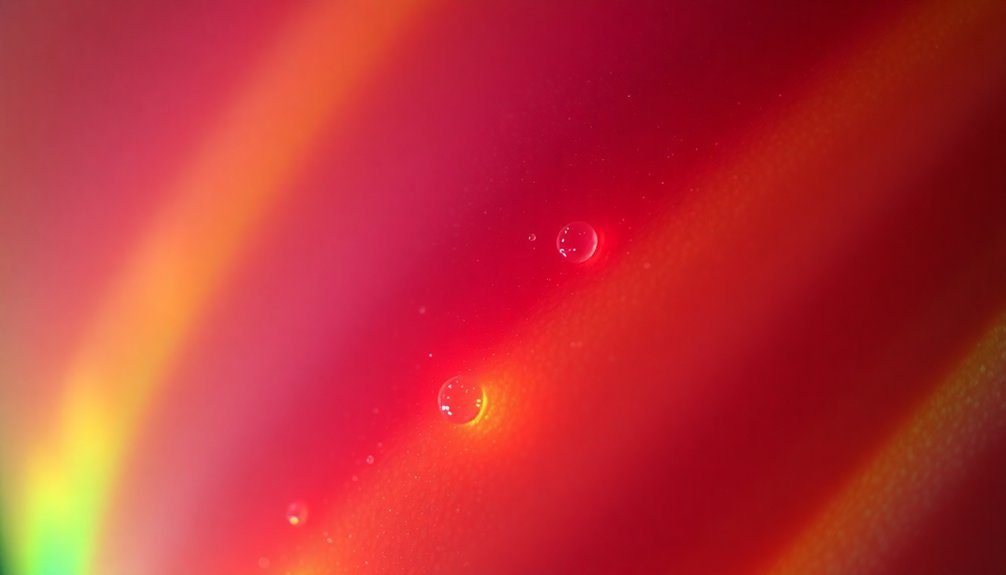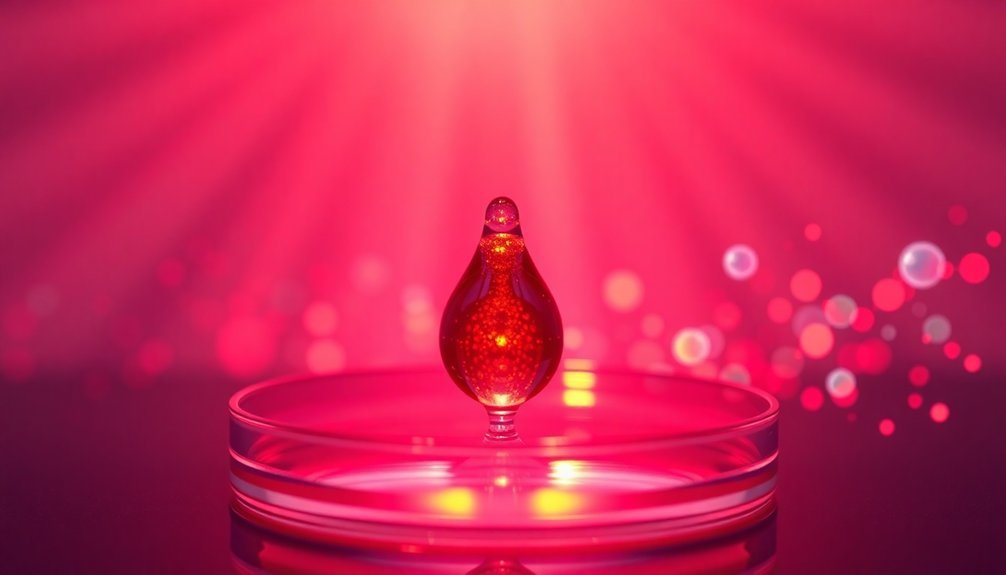Light therapy changes inflammation biomarkers considerably. It reduces proinflammatory cytokines like IL-1β, IL-6, and TNF-α, helping lower inflammation in your body. By increasing ATP production in your cells, it enhances healing and reduces oxidative stress. You'll find that it also boosts anti-inflammatory cytokines, like IL-10, improving immune function. This non-invasive treatment is effective for various conditions, including arthritis and skin disorders. Just 30 minutes a day can make a difference. If you're curious about how this therapy actually works and its benefits, there's more to learn regarding its impact on overall health.
Mechanisms of Action

Light therapy's mechanisms of action involve a series of cellular level changes that enhance healing and reduce inflammation. When you expose your body to light therapy, photon absorption by cytochrome c oxidase in your mitochondria considerably increases ATP production, boosting your cellular energy. This enhanced energy not only promotes various healing processes but also reduces oxidative stress, allowing for improved cell survival and proliferation.
Additionally, light therapy increases nitric oxide production, enhancing blood flow and promoting effective tissue repair. As circulation improves, your body's ability to deliver oxygen and essential nutrients to inflamed tissues enhances, speeding up the healing process. You'll notice that waste products and inflammatory mediators get removed more efficiently, contributing to faster inflammation resolution. Moreover, this therapy promotes neurogenesis in affected areas, further supporting the healing process.
Furthermore, this therapy triggers a brief burst of reactive oxygen species (ROS), activating protective cellular mechanisms. These changes facilitate cellular repair and regeneration, as light therapy activates transcription factors that lead to new protein synthesis.
Proinflammatory Cytokine Reduction
When you explore proinflammatory cytokine reduction, you'll notice how light therapy specifically targets key players like IL-1β and IL-18. Understanding the mechanisms behind this suppression can reveal its clinical applications, particularly in conditions like chronic pain and post-surgical recovery. This therapy has also been shown to reduce inflammation in various conditions, aiding overall recovery processes.
Mechanisms of Cytokine Suppression
Through innovative approaches in therapy, there's growing evidence that red and near-infrared (NIR) light can greatly influence the suppression of proinflammatory cytokines.
When you expose cells to red or NIR light, you can witness a downregulation of cytokines like IL-1β and IL-18, particularly under conditions that induce inflammation, such as LPS treatment. This therapy also reduces TNF-α and IL-6 levels in specific cell types, showcasing its impactful role in inflammation management. Notably, spermine's role as an inhibitor of proinflammatory cytokine synthesis complements the positive effects of light therapy.
You may find that combining red light therapy with a 40 Hz gamma frequency flicker further enhances its anti-inflammatory effects by fine-tuning cytokine expression. Among its benefits, red light therapy promotes an increase in the anti-inflammatory cytokine IL-10, helping your body maintain immune balance while dampening excessive inflammation.
Moreover, the therapy impacts key signaling pathways, such as NF-κB and MAPK, which play significant roles in regulating cytokine production.
Specific Proinflammatory Cytokines Targeted
Many studies highlight the effectiveness of various light therapies in targeting specific proinflammatory cytokines, greatly contributing to inflammation management.
Red light therapy, for instance, considerably reduces TNF-α expression in immune cells and lowers IL-6 and IL-8 secretion in various human cell models. You'll find that it also diminishes proinflammatory cytokines in atopic dermatitis and burn healing models.
On the other hand, near-infrared light therapy effectively attenuates inflammation by decreasing TNF-α and NF-kB expression in burn wounds, along with reducing IL-1β and iNOS levels in cerebral ischemia models. If you look closer, it also downregulates inflammatory markers like IL-6 and COX-2 in inflammatory conditions.
Though still less documented, green light therapy shows promise in reducing hyperalgesia and inflammatory cell infiltration in certain models.
Throughout these therapies, TNF-α is consistently targeted, with IL-6 and IL-8 also showing reductions. Fundamentally, employing light therapy can considerably affect these critical proinflammatory cytokines, pushing you closer to better inflammation management and recovery.
Clinical Applications and Outcomes
Numerous clinical applications demonstrate light therapy's effectiveness in reducing proinflammatory cytokines and alleviating inflammation-related conditions. When you consider using this therapy, you'll find that it positively impacts various disorders, enhancing healing and well-being.
Here's a quick look at some of the outcomes you can expect:
| Condition | Outcome |
|---|---|
| Osteoarthritis | Reduced inflammation and pain |
| Traumatic Brain Injury | Improved recovery and reduced edema |
| Inflammatory Skin Disorders | Lowered proinflammatory cytokines |
| COVID-19-induced distress | Decreased hyper-inflammation |
| Rheumatoid Arthritis | Enhanced joint mobility and comfort |
Anti-Inflammatory Cytokine Enhancement

When you use light therapy, you're not just reducing inflammation; you're actively boosting important anti-inflammatory cytokines like IL-10.
This upregulation enhances healing pathways and increases antioxidant production, helping your body effectively combat inflammation.
Understanding these mechanisms can shed light on how light therapy offers profound benefits for various inflammatory conditions.
IL-10 Upregulation Effects
IL-10 plays a pivotal role in enhancing the body's anti-inflammatory response through its upregulation by light therapy, particularly photobiomodulation (PBM). When you undergo PBM, the red and near-infrared light wavelengths stimulate your cells to produce more IL-10. This boost helps modulate your immune response by curbing the production of pro-inflammatory cytokines like TNF-α and IL-1β.
As IL-10 levels rise, you'll notice a decline in key pro-inflammatory cytokines such as IL-1β, IL-6, and TNF-α. This shift is crucial for preventing chronic inflammation and conditions linked to it, like arthritis or autoimmune disorders. Fundamentally, IL-10 makes your environment less inflammatory, promoting healing and reducing symptoms associated with inflammation.
You'll also benefit from its role in regulating T-cell responses, which helps in keeping your immune activation in check. By enhancing IL-10 production, PBM offers a non-invasive approach to managing inflammation, leading to reduced tissue damage and faster healing.
With positive clinical outcomes associated with chronic inflammatory conditions, leveraging PBM to boost IL-10 is a promising strategy for better health.
Healing Pathways Activation
A significant benefit of light therapy lies in its ability to activate healing pathways that enhance the production of anti-inflammatory cytokines. By modulating cytokine levels, you can experience significant relief from inflammation.
Here are some key mechanisms through which light therapy helps:
- Cytokine Modulation: It downregulates pro-inflammatory cytokines like TNF-α and promotes anti-inflammatory cytokines such as IL-10, effectively resolving inflammation.
- Inflammatory Signaling Pathways: Infrared light exposure reduces activity in pathways involving inflammatory markers, particularly lowering NFkB and AP1 activity, essential for inflammation management.
- Enhanced Cellular Repair: Light therapy boosts ATP production in cells, which supports energy-intensive repair processes, thereby enhancing tissue regeneration.
- Clinical Applications: You can utilize light therapy effectively at home for various conditions linked to inflammation, including arthritis or autoimmune disorders, with minimal contraindications.
Antioxidant Production Enhancement
Light therapy significantly boosts antioxidant production, enhancing the body's ability to combat inflammation. By increasing the levels of anti-inflammatory cytokines like IL-10, light therapy plays an essential role in reducing the production of pro-inflammatory cytokines such as IL-1β and IL-6. This modulation occurs through specific pathways, particularly NF-κB and MAPK, that govern cytokine expression.
Particularly, after just two days of exposure to infrared light, you could see up to a 50% decrease in gene expression markers linked to inflammation. Even more impressive, research shows that short durations of high-intensity infrared light can cut IL-6 secretion by 75%. This reduction is significant in managing conditions characterized by excessive inflammation.
On a cellular level, light therapy enhances your body's energy production, aiding in the healing process and modulating reactive oxygen species (ROS) to help maintain immune system balance. The resulting boost in antioxidant levels fosters an environment conducive to tissue repair and regeneration, ultimately supporting your overall health.
Whether you're dealing with arthritis or inflammatory skin disorders, light therapy offers a non-invasive way to lower inflammation and promote healing.
Specific Conditions Benefiting From PBM
When it comes to specific conditions benefiting from photobiomodulation (PBM), research highlights its considerable impact across various health issues, particularly in brain disorders, joint and musculoskeletal conditions, and skin disorders.
PBM therapy stands out for its ability to reduce inflammation and promote healing in these areas.
Here's how PBM positively affects specific conditions:
- Brain Disorders: It reduces neuroinflammation, helping improve cognitive function in Alzheimer's patients and aiding recovery post-stroke.
- Joint and Musculoskeletal Conditions: PBM decreases inflammatory markers in conditions like rheumatoid arthritis by altering macrophage activity and reducing pro-inflammatory cytokines.
- Skin Disorders: It effectively treats inflammatory acne, eczema, and psoriasis by lowering inflammation and oil production, enhancing skin health.
- General Inflammatory Conditions: PBM lowers overall inflammation in wounds and other areas by upregulating anti-inflammatory factors, making it versatile for various inflammatory conditions.
Incorporating PBM into treatment regimens can considerably improve outcomes for those dealing with these conditions, offering a promising approach to managing inflammation and supporting recovery.
Treatment Methods and Parameters

Photobiomodulation (PBM) therapy employs specific treatment methods and parameters that enhance its effectiveness in reducing inflammation. You'll often encounter red and near-infrared (NIR) light, particularly at wavelengths of 640 and 880 nm. These light wavelengths stimulate cellular energy by boosting mitochondrial function.
To optimize anti-inflammatory effects, consider using a 40 Hz gamma frequency flicker during your sessions. For best results, aim for daily treatments lasting about 30 minutes for a duration of 10 days. Consistency is key—regular applications are essential for seeing significant improvements.
You can use various devices, including LED light therapy and low-level laser therapy (LLLT) devices, which are tailored for both clinical and at-home use. Keep in mind that NIR light penetrates deeper than red light, enhancing its effectiveness.
Research suggests that combining multiple wavelengths can yield better outcomes than sticking with a single wavelength. Pre-treating with PBM before an inflammatory trigger can also help reduce subsequent inflammation.
Systemic and Central Inflammation Effects
The effects of red light therapy on systemic and central inflammation are increasingly gaining attention for their potential health benefits. This non-invasive treatment can help reduce inflammation markers in your body, positively impacting various health conditions.
Here's what you should know about the effects of red light therapy:
- Reduction in Inflammatory Markers: It lowers reactive oxygen and nitrogen species while decreasing pro-inflammatory cytokines like TNF-α and IL-1β.
- Impact on Chronic Diseases: Red light therapy may mitigate chronic inflammation linked to obesity, type 2 diabetes, and inflammatory bowel diseases, promoting better health outcomes.
- Mechanisms of Action: By stimulating mitochondrial function, it boosts cellular energy, which plays a role in reducing inflammation and enhancing cell survival.
- Neuroinflammation Reduction: The therapy penetrates the brain, decreasing pro-inflammatory markers and inhibiting microglia activation, which is essential for brain health.
These effects highlight red light therapy's potential in managing systemic and central inflammation, paving the way for better treatment strategies for chronic diseases and inflammatory conditions.
Implications for Immune System Modulation

As research into light therapy expands, its implications for immune system modulation become increasingly evident. This therapy enhances cellular energy production by stimulating mitochondria with red and near-infrared light, markedly boosting ATP levels. With more energy, your lymphocytes become more active and efficient in fighting pathogens, improving overall immune function.
Moreover, light therapy reduces pro-inflammatory cytokines like TNF-alpha, IL-1, and IL-6. By lowering these inflammatory markers, it helps create a balanced environment for immune responses, fostering lymphocyte activity. Following treatment, you'll notice a decrease in excessive inflammation, contributing to a more regulated immune system.
Light therapy also improves blood flow through vasodilation, ensuring effective transportation of immune cells to sites needing attention. Increased circulation not only delivers essential oxygen and nutrients but also aids in waste removal, boosting overall cell health.
Directly, the therapy stimulates the proliferation of T-lymphocytes, enhancing their ability to respond to antigens. This leads to stronger adaptive immunity, ensuring your body is well-equipped to tackle infections.
In short, light therapy stands out as a promising tool for modulating immune functions effectively.
Frequently Asked Questions
Can Light Therapy Be Combined With Other Treatments for Inflammation?
Yes, you can combine light therapy with an anti-inflammatory diet, supplements, exercise, and even pharmaceutical treatments. This approach enhances the overall effectiveness, helping you manage inflammation and improve your well-being more effectively.
How Long Does It Take to See Results From Light Therapy?
You can start noticing results from light therapy within 10 days, especially with consistent daily sessions of 10-30 minutes. For quicker effects, try two 10-minute high-intensity infrared sessions, often showing results in just 48 hours.
Are There Any Side Effects Associated With Light Therapy?
Yes, light therapy can have side effects. You might experience mild irritation or headaches, and in some cases, sleep disturbances. Always follow guidelines to minimize risks and consult a professional if you have concerns.
Is Light Therapy Safe for All Age Groups?
Yes, light therapy's safe for all age groups. It's non-invasive, low-risk, and doesn't involve harmful UV light. Just follow instructions, wear eye protection, and you'll benefit without significant side effects or age restrictions.
How Does Light Therapy Affect Inflammation in Chronic Diseases?
Light therapy reduces inflammation in chronic diseases by promoting cellular repair, boosting mitochondrial function, and improving blood flow. It lowers inflammatory markers, alleviates pain, and supports recovery in conditions like arthritis and inflammatory skin disorders.
In Summary
To summarize, light therapy offers a promising approach to managing inflammation by reducing proinflammatory cytokines and enhancing anti-inflammatory responses. Its effectiveness in treating various conditions shows its potential as a valuable tool for improving health. By understanding how treatment methods and parameters influence outcomes, you can better utilize this therapy for systemic and central inflammation. Embracing this innovative solution could greatly benefit your immune system and overall well-being.





Leave a Reply